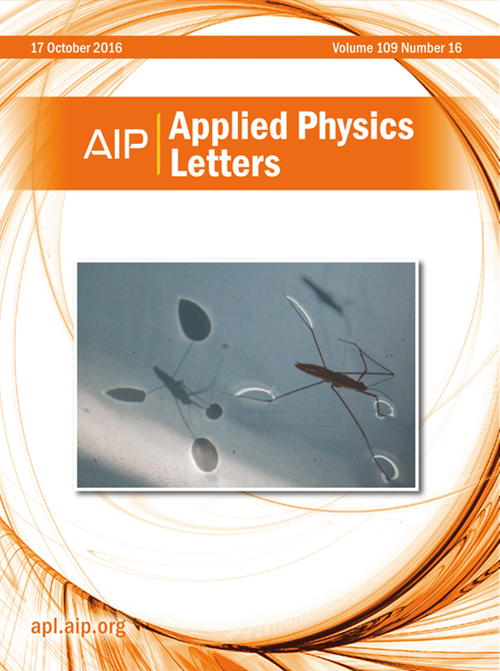室温激光波长接近4和4.4 μ m的低阈值inas基带间级联激光器
IF 3.5
2区 物理与天体物理
Q2 PHYSICS, APPLIED
引用次数: 0
摘要
波长4 ~ 5 μm的中红外激光光谱对CO2 4.23 μm、N2O 4.45 μm和CO 4.60 μm的温室气体具有超高的灵敏度和选择性。它可用于环境监测、实时工业过程控制、医疗诊断/治疗和其他应用。在这项工作中,我们报告了在室温(RT)下具有最短发射波长的带间级联激光器(ICLs)的重大进展。得益于分子束外延生长参数的精确控制,ICL结构在80 K时的低阈值电流密度为1.9 a /cm2,得到了高质量的外延生长。通过降低材料质量优良的InAs的Urbach尾吸收损耗,在300 K下实现了脉冲工作波长为4.02 μm的广域(BA)器件,阈值电流密度为232 a /cm2,是基于InAs的ICLs中最低的。这些BA器件能够在连续波(cw)模式下高达258 K的温度下以89%的最大电压效率工作,在脉冲模式下高达378 K,这表明改善了散热,窄脊器件具有足够的温度范围,可以在RT及以上的温度下实现连续波工作。这些已展示的器件特性表明,低成本的基于inas的ICLs在宽中红外波长区域的实际应用具有很高的潜力。本文章由计算机程序翻译,如有差异,请以英文原文为准。
Low threshold InAs-based interband cascade lasers with room temperature lasing wavelengths near 4 and 4.4 μ m
Mid-infrared laser spectroscopy at wavelengths of 4–5 μm is important for the detection of greenhouse gases, including CO2 at 4.23 μm, N2O at 4.45 μm, and CO at 4.60 μm, with ultra-high sensitivity and selectivity. It can be used in environmental monitoring, real-time industrial process controls, medical diagnosis/therapeutics, and other applications. In this work, we report significant advances in interband cascade lasers (ICLs) with the shortest emission wavelengths among InAs-based ICLs at room temperature (RT). Benefiting from the precise control of the growth parameters in molecular beam epitaxy, ICL structures were epitaxially grown on InAs substrates with high-quality that is validated by a low threshold current density of 1.9 A/cm2 at 80 K. By minimizing the Urbach tail absorption loss in InAs with excellent material quality, broad-area (BA) devices emitting at 4.02 μm in pulsed operation are demonstrated at 300 K with a threshold current density of 232 A/cm2, which is the lowest among the InAs-based ICLs. These BA devices were able to operate with a maximum voltage efficiency of 89% at temperatures up to 258 K in the continuous wave (cw) mode and to 378 K in the pulsed mode, indicating improved thermal dissipation and a sufficient temperature range for narrow ridge devices to achieve cw operation at RT and above. These demonstrated device features suggest high potential of low-cost InAs-based ICLs for real-world applications in a wide mid-infrared wavelength region.
求助全文
通过发布文献求助,成功后即可免费获取论文全文。
去求助
来源期刊

Applied Physics Letters
物理-物理:应用
CiteScore
6.40
自引率
10.00%
发文量
1821
审稿时长
1.6 months
期刊介绍:
Applied Physics Letters (APL) features concise, up-to-date reports on significant new findings in applied physics. Emphasizing rapid dissemination of key data and new physical insights, APL offers prompt publication of new experimental and theoretical papers reporting applications of physics phenomena to all branches of science, engineering, and modern technology.
In addition to regular articles, the journal also publishes invited Fast Track, Perspectives, and in-depth Editorials which report on cutting-edge areas in applied physics.
APL Perspectives are forward-looking invited letters which highlight recent developments or discoveries. Emphasis is placed on very recent developments, potentially disruptive technologies, open questions and possible solutions. They also include a mini-roadmap detailing where the community should direct efforts in order for the phenomena to be viable for application and the challenges associated with meeting that performance threshold. Perspectives are characterized by personal viewpoints and opinions of recognized experts in the field.
Fast Track articles are invited original research articles that report results that are particularly novel and important or provide a significant advancement in an emerging field. Because of the urgency and scientific importance of the work, the peer review process is accelerated. If, during the review process, it becomes apparent that the paper does not meet the Fast Track criterion, it is returned to a normal track.
 求助内容:
求助内容: 应助结果提醒方式:
应助结果提醒方式:


